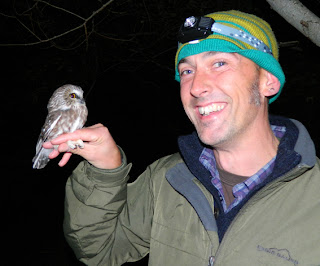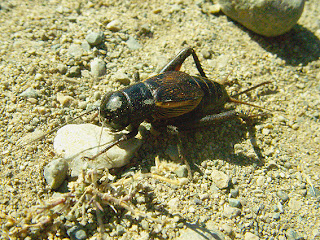Yesterday (Monday) was Thanksgiving here in Canada and as such we enjoyed a nice long weekend. The weather continues to hold out, and we had bright, calm, warm conditions which is all very pleasant for almost everyone, but it does mean that migratory species are not quite so prone to dropping in with occasional downpours or getting blown off-course. We birders really need some rain…
I got out for a while yesterday afternoon and spent a couple of hours scouring the stretch of coast from McMicking Point to Clover Point, taking in the Chinese cemetery and Harling Point on the way.
The main reason for my choice of location was heavily influenced by my desire to try to find that intriguing grebe I saw last week, but as it happened I only saw one western grebe (and was definitely a western grebe).
 |
| Marbled murrelet |
The birding was pretty good overall and there were large numbers of birds out on the water. Surf scoter numbers have really built up in the past few days and there were at least 240 present. Other sea ducks were pretty much absent, with the exception of several harlequins.
Alcids were well represented with common murres, rhinoceros auklets and pigeon guillemots scattered around the water. I also saw at least 8 marbled murrelets, including a pair fairly close in that were constantly calling, in-between dives (one pictured, mid-call). I've never heard this species vocalising before, so that was quite a treat!
The absolute highlight was a pair of ancient murrelet, seen between Harling Point and Trial Island. Rather coincidentally, I saw my first ancient murrelets on the same date last year when I joined a mini-pelagic trip out from Victoria, and these were the first that I have seen since!
The expected shorebirds were all seen picking their way along the coastal rocks - surfbirds, black oystercatchers and black turnstones. At least 4 western sandpiper remain at Clover Point.
A single Pacific loon and several common loons, many starting to moult out of breeding plumage, were sighted.
There was nothing of note among the many common gull species. Heermann's, California, mew, glaucous-winged and Thayer's were all seen in varying numbers.
Census Working Over Time
The previous day I had the pleasure of doing the census at Pedder Bay, Rocky Point Bird Observatory's sister site out at Metchosin.
While the banders were extremely busy processing large numbers of migrant sparrows and the like, I went off to see what I could find along the census route. Generally speaking it was fairly unremarkable, though as always enjoyable. In fact the highlights came pre- and post-census, with a northern shrike hunting below the bluff, and flock of 9 dazzling evening grosbeaks and a pair of red-breasted sapsuckers around the RV park.
Another notable highlight was a European starling doing a very credible imitation of a California quail - I've heard them mimic Eurasian curlew many times in the UK, but this was a totally new one for me!
I left Pedder Bay late morning and drove the short distance to Aylard's Farm, in East Sooke Regional Park to see if the northern hawk owl found there the day before was still in the area. I only saw 2 other birders looking for the diurnal owl, so I guessed that it had moved on. I had a look around, checking any likely looking spots but drew a blank. A single American kestrel was scant compensation.
The vagrant owl had been discovered late in the afternoon on Saturday, characteristically hunting from a perch overlooking a large open area of tall dry grass. Given the limited suitable habitat, and the fact that this is a renowned raptor migration watchpoint, it wouldn't surprise me if it simply continued across the straits or maybe just moved along the coast, where it may yet get relocated. Areas of clearcut forest or open farmland with handy exposed hunting perches are likely sites to check, but it is a bit of needle in a haystack situation!
Little To See at Sea
 |
| Me and Race Rocks Lighthouse |
On Saturday Jenny joined me for a mini-pelagic trip organised by the Victoria Natural History Society. The day was warm, sunny and extremely calm. Ideal for a nice boat journey I'm sure you'll agree, but not much use when it comes to good seabirding conditions.
It was pretty dead out there and we struggled to find anything that we couldn't easily see from shore. Alcid numbers were pretty low, there were no phalaropes, loons and grebes were at something of a premium and other than a smart adult western gull at Race Rocks and the Bonaparte's gulls hanging around the kelp off Rocky Point, larids were seriously lacking in diversity.
We did get great looks at (and quite a noseful of) the belching, garrulous California and Steller's sealions at Race Rocks (pictured), but despite a couple of claims from others on board I certainly didn't pick out any of the handful of elephant seals that have been present lately.
Pity, it would have been a mammal tick!
Rough Justice
After posting Friday's blog, I went for a quick evening stroll around the grounds of the Government House, a short walk from our apartment here in the Rocklands area of Victoria.
Within seconds of passing through the gates it was quite clear that there was lots going on, with small feeding groups of sparrows and robins all around the place. I soon found a smart tan-striped white-throated sparrow in among mixed bunch of golden-crowned sparrows, dark-eyed juncos, white-crowned sparrows and a couple each of song and fox sparrows.
Buoyed by this locally scarce migrant (my second of the fall at this site) I trudged on, feeling quite pleased that I'd made the effort to come down. The remainder of the grounds seemed pretty quiet, with just a couple of ruby-crowned kinglets and yet more juncos to keep me entertained.
A raptor caught my eye as it passed overhead, and getting my bins on it it was immediately apparent that this was no Cooper's or red-tailed hawk. Pale underparts, a broad diffuse dark tail band with 'wrap-around' pale base, dark belly, primary tips and striking black carpal patches; clearly a pale juvenile rough-legged hawk (known as rough-legged buzzard to a Brit birder). My first 'rough-leg' in Canada and the last bird I expected to see flying over Victoria!
Interesting fact - the bird's feathered feet (an adaptation for Arctic life) are reflected in its scientific name Buteo lagopus, lagopus meaning 'hare-footed'. Cool eh?

















